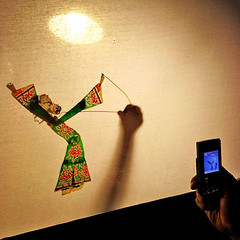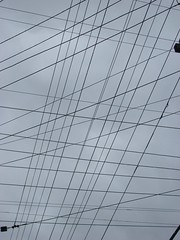I recently lamented in Twitter that my blog posting has become shovelware from my presentations. That mostly shows how busy I am--which is actually good--but it's also a shame, since I like having the time to use this as the public notebook it's supposed to be. However, even though I don't have time to update the blog as often I would like, I realized that I'm still generating content that's not in formal presentation or book form. It just (as Paul Boutin recently noted in Wired) just happens in different channels. Here's two more pieces of shovelware, one from a familiar source (a talk I gave at UC Berkeley's School of Information) and one from a different source.
Materials that dematerialize
 (image CC by Only Sequel)
(image CC by Only Sequel)
In what's becoming a ThingM tradition, I spoke last Thursday at Prof. Kimiko Ryokai's Tangible Interfaces class at UC Berkeley. Tod spoke to the same class last school year. My presentation was called Materials that Dematerialize ( 740K PDF) and it brought together several high-level thoughts I've had recently about how the social effects of ubiquitous computing and Internet of Things technologies create challenges for experience designers. Specifically, it brings together the themes of "information processing as a material" and "information shadows that turn everyday objects into services" that I've recently been thinking about.
Cloud computing, ubicomp, service design, interaction design
Here's a discussion that I had with Tom Igoe and Brian Slesinsky on Facebook in response to another Twitter post I had made (you can find the original here).
Mike Kuniavsky at 6:02pm November 10
A thought: service design is what links cloud computing and ubicomp. It meets industrial/interaction design at the device/service interface.
Tom Igoe at 6:14pm November 10
How exactly does cloud computing differ from the web?
Mike Kuniavsky at 6:20pm November 10
There's terminology slippage, for sure. You could also ask how the Web is different from the 'Net. I think it's a question of where the data lives and whether devices are expected to be the homes of data, or whether data primarily lives in centralized services that live on the Net and are exposed and manipulated by a variety of devices, some of which are physical, some of which live on the Web or other distribution mechanisms. I agree that I think that "grid computing," "distributed computing," "cloud computing" and "service oriented architecture" are probably all describing the same concept. I'm trying to use the most evocative terms and to relate them.
Tom Igoe at 6:29pm November 10
I think the web and the net, there's a qualitative leap there, because the former made visual communication easy, right? I'm still undecided on whether cloud computing offers any new insights on what we're doing.
Service design kinda does, in that it suggests a different way of approaching the problem, in terms of who owns the assets. Though it's basically what Ray Anderson was on about in "Mid Course Correction," but his thinking on that pre-dates service design, and his action probably pre-dates the web. Seems service design mostly gives a name to the concept, and the net -- and the web, if you want -- make it easier to implement.
Sometimes I wonder what ubicomp would have looked like if the web hadn't happened. I suspect the banks and credit card companies would have made it happen anyway.
Brian Slesinsky at 9:34pm November 10
If you don't know or care which machine(s) your application is running on, it lives in the cloud.
Mike Kuniavsky at 11:24am November 11
The question is in the definition of "application." It used to be relatively straightforward to figure out where "the code" ran, but when a widget on my phone sends an SMS to a service that's then syndicated to an aggregator which then generates addition information that's then displayed back on my phone, what's the "application"? That's why the service becomes the focus of the design, because there are now many possible ways that a person can interact with a single set of functions, still have it feel like a single thing at the core, even though there is no single "application" that's running on a single "machine." Think of how the service of banking is provided through ATMs, online banking, phone banking and human tellers, all of which run different codebases on different hardware, and yet still deal with the same money.
[On a tangential note, I was first exposed to the ideas of cloud computing when it was presented as the Andrew File System, a distributed file system that was being worked on at the University of Michigan in the late 80s and early 90s when I was there. It's interesting to see how the ideas of using networks to distribute computing evolve. In many ways the core ideas don't change, but the model of what people need changes, and what was considered esoteric and irrelevant suddenly becomes interesting when framed a different way. In this case, the distributed file system was abandoned and forgotten until it re-emerged as a service distribution infrastructure.]




